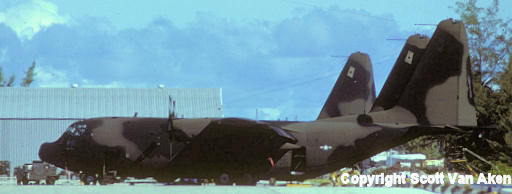 Osprey's
Raid series has been one of their more interesting offerings. This is one that
has particular interest to me as all the air assets of the mission staged
through Diego Garcia when I was posted there and I had the chance to see these
aircraft at that time. Here is a photo I took of the three MC-130s.
Osprey's
Raid series has been one of their more interesting offerings. This is one that
has particular interest to me as all the air assets of the mission staged
through Diego Garcia when I was posted there and I had the chance to see these
aircraft at that time. Here is a photo I took of the three MC-130s.
 Eagle Claw
was one of those operations that was pretty much a learning experience for all
involved. Delta Force, which was the main assault unit, had only recently been
formed and had never participated in an operation before. The planning was
fairly well done, but totally failed to take into considerations warnings from
the experts regarding the weather conditions that could prevail in the Iranian
desert, a mistake that eventually led to the failure of the mission.
Eagle Claw
was one of those operations that was pretty much a learning experience for all
involved. Delta Force, which was the main assault unit, had only recently been
formed and had never participated in an operation before. The planning was
fairly well done, but totally failed to take into considerations warnings from
the experts regarding the weather conditions that could prevail in the Iranian
desert, a mistake that eventually led to the failure of the mission.
Add to it the original need for such tight operational
security, that those units that had experience of somewhat similar operations
during Vietnam were totally left out of the loop. An example of this was the use
of USN RH-53D helicopters. These are mine sweeping helos and the Navy pilots had
zero experience with low level combat insertion and extraction techniques. So
the head of Delta Force used Marines to pilot these helos. Unfortunately, the
RH-53D and the USMCs RH-53A/E helicopters are similar but not exactly the same.
USAF combat SAR pilots and planes would have been the logical choice but were
not used.
A number of other factors, including the intransience of
operational leadership regarding absolute radio silence during the mission, led
to errors that cost the lives of some of those participating in the operation,
loss of aircraft, and the hurried evacuation of the landing site left intact
helicopters as well as top secret operational information and codes that were
obtained by the Iranians. However, one good thing came from this and that was
that lessons were learned and future operations of this type were a lot more
successful.
The author has really done a fine job telling this
story. His research goes a long way to helping to provide a fairly detailed
account of the build up to the operation, the operation itself, and the
aftermath. This is a great read and one that you should have in your library.
January 2020
Copyright ModelingMadness.com. All rights reserved.
For more on the complete line of Osprey books,
visit
www.ospreypublishing.com
If you would like your product reviewed fairly and quickly, please
contact
the editor or see other details in the
Note to
Contributors.
 Osprey's
Raid series has been one of their more interesting offerings. This is one that
has particular interest to me as all the air assets of the mission staged
through Diego Garcia when I was posted there and I had the chance to see these
aircraft at that time. Here is a photo I took of the three MC-130s.
Osprey's
Raid series has been one of their more interesting offerings. This is one that
has particular interest to me as all the air assets of the mission staged
through Diego Garcia when I was posted there and I had the chance to see these
aircraft at that time. Here is a photo I took of the three MC-130s.  Eagle Claw
was one of those operations that was pretty much a learning experience for all
involved. Delta Force, which was the main assault unit, had only recently been
formed and had never participated in an operation before. The planning was
fairly well done, but totally failed to take into considerations warnings from
the experts regarding the weather conditions that could prevail in the Iranian
desert, a mistake that eventually led to the failure of the mission.
Eagle Claw
was one of those operations that was pretty much a learning experience for all
involved. Delta Force, which was the main assault unit, had only recently been
formed and had never participated in an operation before. The planning was
fairly well done, but totally failed to take into considerations warnings from
the experts regarding the weather conditions that could prevail in the Iranian
desert, a mistake that eventually led to the failure of the mission.